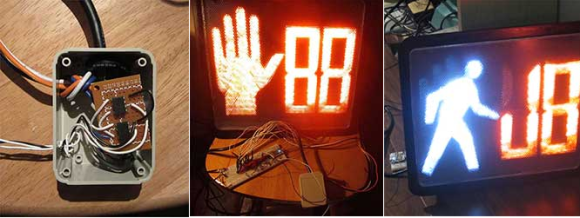
[Jon Bennett] is an electrical engineer who specializes in embedded systems software. He was the first employee of Pebble Technology and the lead developer of the inPulse Smart Watch. He has studied at the University of Waterloo during which he completed several interesting internships, including working on Bluetooth and WiFi embedded software for the iPhone (Apple, 2007). Now, he has hooked up this pedestrian walk signal — picked up at an electronics surplus store — to the internet.
The web-enable project utilizes a Spark Core Wifi Module, which is an Arduino-like micro-controller with more power, to wirelessly connect to the device. With the click of a button, the hand signal can be flashed. The walking illuminated man can be triggered with another press. Messages can be sent scrolling across the LED’s flashing by in sets of two simply by hitting enter.
All the source code has been posted on Github in case anyone wants to create their own.

[Jon]’s previous work can be found in a few of our featured articles from a couple of years ago. There’s the Thrift Shop Wifi Router Robot he made that could be controlled through the internet. He also built this interactive bubble music visualizer, and this programmable RC car that can be driven by a computer.
What will he think of next??















I like that 2nd picture.
Is he looking for a job? Why list all of his qualifications? The writeup seems much more like an advertisement for Jon Bennett than anything about the project itself.
Exactly what I thought. On this site the project/hack/whatever should be in the focus, not so much who did it.
If the signs had strategically disabled illumination they might be more fun to control/display. The Ax-Man Surplus store (awesome store) posted this yesterday. https://www.facebook.com/146851144623/photos/a.353943149623.153261.146851144623/10152322387919624/?type=1
@untrustworthy
I wish my qualifications weren’t highlighted. I think it took away the focus from the project :\.
Good job. I liked what you did to my old design… I designed most of the circuit you see on this PCB. 2 flyback in constant current for the hand and pedestrian LED strings and a third one in constant voltage for the MCU and 7 segments. But you should have been able to use the LED driver IC already on the board for both ‘7 segments’ ; )